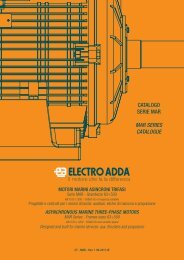You also want an ePaper? Increase the reach of your titles
YUMPU automatically turns print PDFs into web optimized ePapers that Google loves.
Carichi ammessi sui cuscinetti<br />
Permissible load on the bearings<br />
La durata di base teorica a fatica dei cuscinetti è calcolata in accordo con<br />
quanto previsto dalla norma ISO R 281-1.<br />
La durata è calcolata nell’ipotesi che i motori siano funzionanti in condizioni<br />
ambientali normali, senza vibrazioni anomale, senza carichi assiali<br />
o radiali oltre quelli indicati nelle tabelle successive e con temperature di<br />
funzionamento dei cuscinetti comprese tra -30°C e +85°C.<br />
La durata così calcolata viene defi nita durata di base (L10h) espressa in<br />
ore di funzionamento.<br />
Il 50% dei cuscinetti raggiunge una durata pari a cinque volte la durata di<br />
base risultante dal calcolo.<br />
Nelle tabelle seguenti sono indicati i massimi carichi assiali e radiali<br />
ammessi per una durata di base (L10h), calcolata con secondo quanto<br />
previsto dalle Norme ISO, pari a 20.000 e 40.000 ore di funzionamento.<br />
Si ricorda che le durate dei cuscinetti sono calcolati su coeffi cienti di<br />
carico dinamico forniti dai costruttori dei cuscinetti.<br />
Tali carichi sono basati sulla durata che si prevede che possa venir raggiunta<br />
o superata dal 90% dei cuscinetti di una campionatura sufficientemente<br />
grande, costituita da unità apparentemente tutte uguali.<br />
Il 50% dei cuscinetti può raggiungere una durata cinque volte superiore<br />
a quella indicata dal calcolo.<br />
Il 10% dei cuscinetti, tuttavia, può non raggiungere la durata di vita calcolata.<br />
The theoretical basic fatigue life for bearings is calculated according to<br />
the provisions of the ISO R 281-1 Standard.<br />
Life is calculated assuming that motors are running under normal ambient<br />
conditions, without abnormal vibrations, without axial or radial loads<br />
beyond the ones mentioned in the following tables and with operating<br />
temperatures of the bearings ranging between -30°C and +85°C.<br />
Life calculated this way is called basic life (L10h) expressed in hours of<br />
operation.<br />
50% of bearings reaches a life equal to five times the basic life resulting<br />
from the calculation.<br />
Next tables show the maximum permitted axial and radial loads for a basic<br />
life (L10h), calculated according to the provisions of the ISO Standards,<br />
equal to 20.000 and 40.000 hours of operation.<br />
It should be noted that the bearing life is calculated on dynamic load coefficients<br />
supplied by bearings manufacturers.<br />
These loads are based on the life that is expected to be reached or exceeded<br />
by 90% of bearings of a sufficiently large sampling, consisting of<br />
units apparently all the same.<br />
50% of bearings can reach a life five times longer than the one indicated<br />
by the calculation.<br />
10% of bearings, however, cannot reach the calculated life.<br />
14 Electro Adda S.p.A. CT - S - Rev. 3 <strong>09</strong>-<strong>2016</strong>-<strong>IE</strong>






